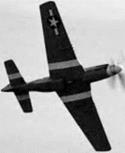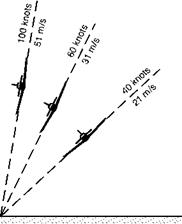The load factor
In order to allow for the extra loads likely to be encountered during aerobatics, every part of an aeroplane is given a load factor, which varies according to conditions, being usually between 4 and 8. This means that the various parts are made from 4 to 8 times stronger than they need be for straight and level flight.
Turning
In an ordinary turn (Fig. 8B) the inward centripetal force is provided by the aeroplane banking so that the total lift on the wings, in addition to lifting the aeroplane, can supply a component towards the centre of the turn (Fig. 8.3, overleaf).
Suppose an aeroplane of weight W newtons to be travelling at a velocity of V metres per second on the circumference of a circle of radius r metres, then the acceleration towards the centre of the circle is V2//- metres per second per second.
Therefore the force required towards the centre
= WWgr newtons
If the wings of the aeroplane are banked at an angle of в to the horizontal, and if this angle is such that the aeroplane has no tendency to slip either inwards or outwards, then the lift L newtons will act at right angles to the wings, and it must provide a vertical component, equal to W newtons, to balance the weight, and an inward component, of WV2/gr newtons, to provide the acceleration towards the centre.
This being so, it will be seen that –
tan в = (WWgr) – t – W = V^-lgr
|
|
|
|
Fig 8B Turning
A Mustang making a tight turn near the ground.
This simple formula shows that there is a correct angle of bank, в, for any turn of radius r metres at a velocity of У m/s, and that this angle of bank is quite independent of the weight of the aeroplane.
Consider a numerical example –
Find the correct angle of bank for an aeroplane travelling on a circle of radius 120 m at a velocity of 53 m/s (take the value of g as 9.81 m/s2).
V= 53 m/s
r = 120 m
tan 0= W/gr = (53 X 53)/(9.81 X 120) = 2.38 с. в = 67° approx
What would be the effect if the velocity were doubled, i. e. 106 m/s? tan в would be 4 X 2.38 = 9.52 с. в = 83° approx
What would be the effect if the velocity were 53 m/s as in the first example, but the radius was doubled to 240 m instead of 120 m?
|
W newtons
|
Fig 8.3 Forces acting on an aeroplane during a turn
|
|
Fig 8.4 Correct angles of bank Radius of turn 50 metres
tan в would be 2.38/2 = 1.19 .•. в = 49° approx
Thus we see that an increase in velocity needs an increase in the angle of bank, whereas if the radius of the turn is increased the angle of bank may be reduced, all of which is what we might expect from experiences of cornering by other means of transport. Figures 8.4 and 8.5 (overleaf) show the correct angle of bank for varying speeds and radii; notice again how the speed has more effect on the angle than does the radius of turn.















